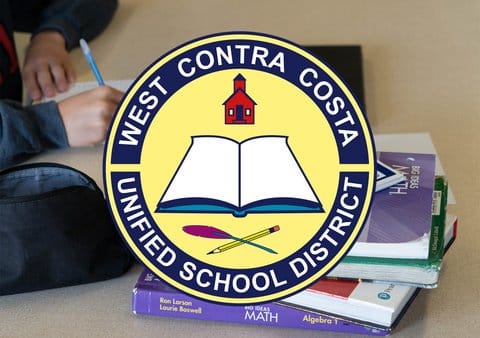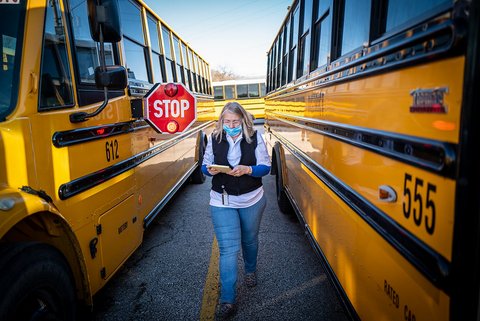
29 Apr EdSource: West Contra Costa Responds to Complaints Filed Over Teacher Vacancies

(Image courtesy of West Contra Costa Unified School District via Bay City News)
By Monica Velez, EdSource
West Contra Costa Unified School District officials responded to complaints filed over ongoing teacher vacancies earlier this month. However, complainants say the district lacks a sufficient plan to fix the problem, and the next steps could include litigation if vacancies are not addressed.
“As teachers, our work is being harmed, our ability to do our job is being harmed,” said Sam Cleare, a West Contra Costa teacher. “But what truly hurts me the most is knowing that these students — I care about them so much — aren’t receiving an education.”
Three teachers in the district, including Cleare, filed complaints on Jan. 31 alleging that the district failed to provide students with qualified teachers, resulting in teachers taking on more classes and sacrificing prep time.
The district’s response acknowledged that the allegations are true — the district was out of compliance with the law because teacher vacancies have not been filled and are being covered by long-term or day-to-day substitutes. According to the response, vacancies weren’t filled because of teacher transfers and late notices from teachers who left the district in the 2022-23 school year.
The district also blames statewide systemic issues for contributing to the problem. Beginning in 2021, California schools had significant increases in teacher vacancies and declines in the number of new teachers, the response said, as the pandemic caused many educators to leave the profession.
“Any vacancy was not purposefully caused by the District,” Camille Johnson, interim assistant superintendent of human resources, said in the response. “The District has provided support and supervision for its students to the best of its ability within these limitations and has not purposefully caused any noncompliance.”
Contra Costa County has 202 teacher vacancies, according to data from UCLA’s Center for the Transformation of Schools. Alameda County has 504, Solano County has 38, and San Joaquin County has 125 vacancies.
To address teacher shortages, the district is continuing to revise its strategies to increase retention and recruitment and has implemented “recruiting, development, and hiring measures.” Additionally, since August, the district has had officials at 25 job fairs and has posted job announcements on at least six job boards.
A coordinator has also been hired to develop and promote pathways for substitutes and employees to become permanent teachers, and the district is partnering with various universities and nonprofits for recruitment, the district’s response said.
Karissa Provenza, an attorney with civil rights law firm Public Advocates who is representing the three teachers said the district’s response is insufficient.
On April 19, nine days after the district responded to the complaints, Provenza sent the school board an appeal on behalf of her clients. The district has until Monday to provide a plan that explains how each vacancy will be filled and have a meeting with Provenza and her clients to address the vacancies.
“Should the district’s response continue to prove inadequate, we and our clients reserve all rights to pursue additional legal measures, including by filing suit in a California Superior Court to compel lawful compliance,” Provenza wrote in the appeal.
The appeal acknowledged the effect teacher shortages have had on schools but said that doesn’t relieve WCCUSD from filling each class with a qualified and credentialed teacher. If substitutes covering some of the vacancies are qualified to be permanently assigned to classes, that could be a short-term solution, the appeal said. Other short-term solutions suggested were placing credentialed administrators into vacancies for the remainder of the school year, employing individuals who hold a short-term staff permit or a provisional internship permit, and employing retired credentialed teachers, which the district has done before.
District officials did not respond to requests for comment on the appeal.
The vacancies
The three educators who filed complaints teach at Stege Elementary, Helms Middle and Kennedy High schools. Each school currently has four vacancies that have been open since the beginning of the school year or sometime in the fall.
At a school like Stege Elementary that has four out of 12 teaching positions vacant, about one-third of students “aren’t receiving an education,” Cleare said. “I’ve seen students blame themselves, or they become less interested in school.”
For the past seven years Cleare has taught at Stege, she said, the school year has either started out with vacancies or someone has left in the middle of the year. Teachers sometimes had extra students in their class for many weeks, Cleare said. She now has a class with fourth and fifth graders because of the vacancies.
“I can’t believe this problem has been going on for so long and so little is being done,” Cleare said. “It almost feels like they don’t care about the students.”
Cleare said she never has enough time to prepare lessons, and it’s common for extra students to be in classes because of substitute and teacher shortages. At one point, she had ages spanning from first to fifth grade in one class.
West Contra Costa has fewer fully credentialed educators teaching in their field compared with the state average. According to data from the state Department of Education, the district had 78% credentialed teachers in the 2021-22 school year — the most recent data available. The state average was nearly 86%.
Excluding charter schools, WCCUSD also has the lowest rates of fully credentialed teachers compared with other districts in Contra Costa County, data shows. All other districts in the county are at 80% or higher.
Chronic absenteeism has been rising because of vacancies, according to the complaints, especially for students who need more support. There have been instances where groups of students were placed in the cafeteria because there weren’t enough teachers. Substitutes have covered some classes since the beginning of the school year to the extent that parents don’t know who is teaching their children day-to-day.
“We are starting to hear from parents who are really upset about what’s going on,” Provenza said. “We are continuing to hear that substitutes are not getting the support they need to support their students — it’s that turbulence that comes along with high number of vacancies.”
Substitutes can be authorized to cover classes for longer periods — usually 30 to 60 days, Provenza said, but at Stege, Helms and Kennedy, substitutes have taught classes longer. At Helms Middle, there’s a large portion of eighth graders who don’t have permanent teachers in math, science and English, the complaints said.
Teacher vacancies are disproportionately affecting students of color, according to the complaints. Stege Elementary has about 38% Black or African American students and 34% Hispanic or Latino students in the 2022-23 school year, according to data from the state Department of Education.
Nearly 83% of students at Helms Middle are Hispanic or Latino and about 7% are Black or African American, data shows. About 73% of students at Kennedy High are Hispanic or Latino and nearly 18% are Black or African American.
Cristina Huerta, the Kennedy High teacher who submitted a complaint, said vacancies have been “severely” affecting students’ ability to take Spanish courses. There are 143 students who are enrolled in Spanish but haven’t had a Spanish-credentialed teacher.
“For the first quarter of the school year, the students had a couple of long-term subs, but that did not last more than a couple of weeks, and then they bounced around as Kennedy teachers covered a different period without access to any curriculum,” Huerta said in an email.
Students have gaps in their Spanish education because some of the teachers covering the class aren’t credentialed to teach Spanish, Huerta said. Students will likely struggle in higher-level Spanish classes in the coming years.
“All in all, the vacancies have been disheartening, and I worry about the future of the Spanish program at Kennedy since the vacancy has been cut for next year, and we are no longer hiring a third Spanish teacher,” Huerta said. “ I’m not sure how our small department will be able to serve the Kennedy student population as they attempt to complete graduation requirements and enroll in higher-level classes for college preparation.”





No Comments